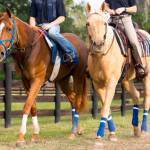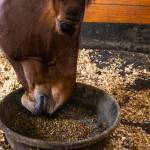Prevalence of Quarter Cracks in High-Performance Horses

Like equine athletes in all disciplines, Thoroughbred racehorses face hoof-related challenges, including quarter cracks. In an effort to better understand this hoof wall abnormality, researchers investigated the incidence, clinical presentation, and future racing performance of Thoroughbreds with quarter cracks over a nine-year period.*
A quarter crack is a full-thickness failure of the hoof capsule between the toe and heel that may extend the entire height of the hoof, from coronary band to ground. The separation often results in unsoundness due to instability of the hoof wall or infection of the deep dermal tissue, though many horses remain free of lameness despite the presence of a quarter crack.
Quarter cracks are thought to arise for many reasons: innate hoof weakness; improper hoof balance; injury or trauma to the coronary band; or infection of the corium, part of the internal vascular network of the hoof. Poor farriery may contribute to hoof imbalance, which could contribute to crack formation. A common finding among horses with quarter cracks is sheared heels, an unevenness of the heels that causes unequal weight-bearing on the bulbs and creates a shearing force absorbed by the hoof capsule.
During the nine-year study period, just over 4,500 horses in a training center were followed. Seventy-four horses had at least one quarter crack during the study period. Twenty horses had two or more quarter cracks. Almost half of all horses with quarter cracks were lame at the onset of the defect.
An overwhelming number of cracks occurred in the fore hooves, and there was a proportional difference in the number of cracks in the left rather than right fore hooves. Most of the cracks came about on the inside of the hooves.
The quarter cracks identified in this study were treated in various ways, though the principle treatments included corrective shoeing with a heart-bar shoe, wire stabilization, and the use of epoxy or acrylic. Treatment goals centered around correcting the hoof imbalance and eliminating uneven movement.
Racing performance following treatment was available for 63 of the 74 horses. Of the 63 horses, 54 horses had at least one start after treatment. When compared to control horses, there was no significant difference in the number of career races, career wins, and career placings for horses with quarter cracks.
As mentioned previously, horses genetically predisposed to weak hoof walls might be susceptible to quarter cracks. Racehorses are generally well-nourished, as trainers know the importance of sound nutrition in conditioning an athlete. Aside from high-quality forage and fortified concentrates, horses inclined to poor-quality hooves should be given a research-proven hoof supplement. Biotin should be a primary ingredient in the supplement, but other ingredients will further support hoof health. A high-quality hoof supplement also contains methionine, iodine, and zinc.
*McGlinchey, L., P. Robinson, B. Porter, A.B.S. Sidhu, and S.M. Rosanowski. 2020. Quarter cracks in Thoroughbred racehorses trained in Hong Kong over a 9-year period (2007-2015): Incidence, clinical presentation, and future racing performance. Equine Veterinary Education 32 (Suppl. 10):18-24.








